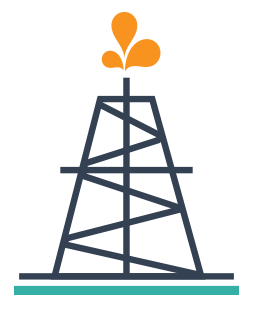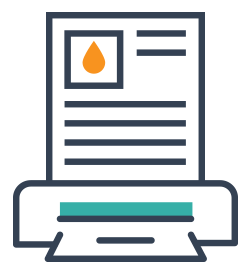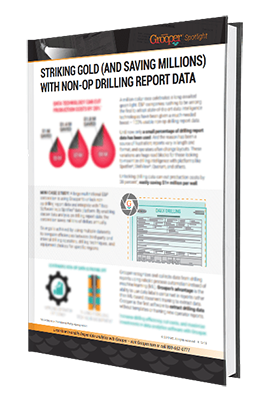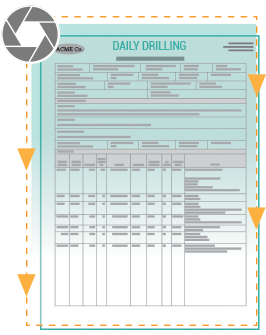It shouldn’t be so hard to get data out of 3rd party reports and statements for quality oil and gas analytics. And now, it’s easier than ever…
A large multi-national oil and gas E&P corporation solved that problem. They’re now integrating much more data from third party reporting.
By unlocking this data and injecting it into their data analytics platforms with Grooper oilfield data management solutions, they’ve increased efficiencies, reduced manual data entry, and improved decision making.
Discover:
Advanced data extraction and preparation is being used in many oil and gas data analytics applications.
Download the case study spotlight and learn more!
How to Benefit from Big Data in the Oil and Gas Industry – Upstream:

Optimize Drilling Processes
As you know, drilling equipment is equipped with numerous sensors to track performance and collect huge amounts of data.
While some of this data is used to prevent machine failures or breakdowns, other data is used to track drilling progress, technique, equipment being used, injury reports and non-productive time.
The information contained in internal and non-op/OBO daily drilling reports can (and is being used) by oil and gas upstream companies to learn:
- How efficient their wells are that are being operated by others
- How efficient are their own wells versus non-op wells
- The most successful technique and equipment for drilling in an area
For a mini-case study that illustrates, and how it’s done, download our Spotlight Brochure:
Lease Processing

Many oil and gas business processes are still paper-based. This includes acquiring and divesting leases, which includes hundreds or thousands of individual paper lease files in one asset purchase.
With a limited time to decide whether leases should be purchased, land, accounting, and other departments are under a big time crunch to manually examine thousands of pages to find the important details.
Big data analytics solutions massively accelerate lease onboarding by scanning lease files, using OCR technology to find the important data, and then extracting that data into business intelligence and data management systems. Grooper software has saved 92% of lease processing time when compared to traditional technologies and methods.
This gives oil and gas companies:
- Much more time to make incredibly important decisions
- More details into leases that help make wiser decisions
- Significant time and cost savings
- More valuable work, as lease analysts can concentrate on higher-value tasks rather than lower-value manual tasks
Learn more about buying and selling oil and gas leases with Grooper.
Improve Reservoir Engineering

There are also many kinds of downhole sensors that can be used to boost reservoir production. Oil and gas companies use temperature sensors, acoustic sensors, pressure sensors, etc. to get a huge amount of data to make decisions on their reservoirs.
For example, with big data analytics, companies can develop reservoir management applications to get timely and actionable information about changes in reservoir pressure, temperature, flow, and acoustics.
The benefits of leveraging this data almost allow a look into the reservoir, which can improve control over operations in order to boost reservoir performance and profitability.
Manage Seismic Data

For this use, upstream analytics begins with collecting seismic data through sensors across a potential area of petroleum source interest. After all data is collected, it can be processed and analyzed to locate the best spots for drilling.
In addition, seismic data can be combined with other data sets (like a company’s historical data on past drilling operations, research data, etc.) to identify the amount of oil in reservoirs.
Big Data in Midstream Oil and Gas:

Logistics in the oil and gas industry is an incredibly complex process. The major concern is transporting oil and gas with the lowest risk possible. Midstream companies use sensor analytics to ensure the safe transport of their resources.
Predictive maintenance software analyzes sensor information from pipelines and tankers to anticipate flaws or possible issues (such as stress corrosion, seismic ground movements, fatigue cracks, etc.), which helps to repair and prevent accidents.
Big Data in Downstream Oil and Gas:

Oil and gas businesses can employ big data predictive analytics tools to decrease refining equipment downtimes and expenses to maintain and repair. This improves asset management and profitability.
To achieve this, downstream companies employ several tools and methods. First, analysis of refining equipment is conducted by comparing past operating data versus current data.
Then, the equipment or tool’s life expectancy is calculated based on it’s end-of-life criteria and failure condition analytics.
Finally, equipment maintenance specialists view and visualize the estimated performance data in order to decide when the equipment assets should be replaced.
The Challenges of Implementing and Using Oil and Gas Big Data
- Transfer of Data off Paper
One of the most critical challenges in creating and managing a digital oilfield is the data transfer from the field to the office (or data processing facility) based on the type of data, amount of data, and data protocols.
This so difficult is due to the fact that a substantial part of oil and gas data is trapped on paper or image-based PDFs. Just a few examples include drilling reports, run tickets, revenue statements, plant and POP statements. - Poor Data Quality
Another challenge of using oil and gas data is the frequency of data collection and the quality of the data collected. In the case of drilling reports, the quality and format can vary greatly from each drilling operator.
In the case of scanned documents that end up as images like PDFs or JPGs, (like lease records or drilling reports), there are many obstacles that present many challenges for machines to accurately extract data, including (but not limited to):
– Poor scan quality
– Differing formats
– Noise or specks
– Boxes or lines near data
– Hole punch or staple marks - How to Apply Big Data Tools and a Sudden Influx of Data?
An important challenge is the thorough understanding of the physics of the problem. For example, expert petroleum engineers could team up with data scientists to leverage the big data tools that give great answers for various problems in the field of petroleum engineering.
Another example is the wealth of data now available that was formerly always hard to access. Document-based data is just now being fully extracted and integrated into business intelligence applications. This data is leading to more knowledge of internal and third-party operations, which results in greater cost savings and increased profits.
Interested to discover how other upstream oil and gas companies are overcoming these big data challenges?
Check out this case study, where we show you how data in drilling reports is being accurately extracted and leveraged like never before!
Big Data Definition
First, what is big data? Big data includes unstructured (meaning data that is not organized but is text-heavy) and multi-structured data (including different data formats that is produced from from people/machines interactions).
The concept of Big Data (also known as business analytics or Big Data Analytics) defines the first property of this method, which is the size of an available data set. There are other properties related to this sort of data that make it ideal for Big Data tools. Those properties are:
- Volume
- Variety
- Velocity
- Veracity
- Value
Properties of Oil and Gas Big Data:
Volume in Oil and Gas Big Data

The property of volume deals with the amount of information or data. A lot of oil and gas data can be generated by a data recording tool or sensor, which tend to generate a lot of data. A substantial volume of data can be challenging to handle and leverage as a result of storage, sustainability, and analysis issues.
Many businesses manage large volumes of data in their repositories, but many don’t have the capability of processing these data. The main application of Big Data is to provide processing and analysis tools with large amounts of ever-increasing data.
Variety in Oil and Gas Big Data

The property of variety deals with the various types of data that are generated, stored, and analyzed. Data recording devices and sensors can also vary in type. As a result, the generated data comes in different sizes and formats.
The formats of the generated data can be in electronic text, image-based text, image, audio, or video format. Data can be classified in a more technically as: structured, semi-structured, and unstructured data.
As it pertains to the oil and gas industry, examples of structured data are pipeline monitoring data, surface and subsurface facility data, asset, risk and project management reports. Examples of oil and gas unstructured data includes well logs, daily drilling reports and CAD drawings. And examples of semi-structured data includes processed data from modeling and simulation.
Velocity in Oil and Gas Big Data

The idea of velocity as a property of Big Data deals with the speed of data transmission and processing. It also deals with how quickly data is generated. The challenging part about the velocity property is the inadequate number of available processors compared to the volume of data. Recently, the velocity of data generation has been large, 5 exabyte of data was generated just in two days. This is equal to the all total data generated by humans until 2003.
For the oil and gas industry, the velocity property is even more noticeable due to the complex nature of various petroleum engineering problems. For a single individual to process large amounts of generated data in order to solve a complex problem is laborious, filled with significant delays possible errors.
And there are many cases in which it is crucial for oil and gas companies to process data fast and in real-time. For example, fast processing of well data during drilling can result in identifying kicks and preventing destructive blow-outs efficiently.
Veracity in Oil and Gas Big Data

The property of veracity deals with the quality and usefulness of data with the goal of using that data to help with analysis and decision making. This really deals with differentiating between dirty and clean data. This is very important as the dirty data can significantly affect the velocity and accuracy of data analysis.
The generated data should be expertly and efficiently processed and filtered to be used for data analysis. If the data is dirty or even questionable, the results will not be reliable. The veracity of data is tough to get in the oil and gas industry mainly due to nature of data, which mainly comes from subsurface facilities and it might include uncertainty.
Another obstacle comes from the data that is collected by conventional manual data recording, which is done by human operators. As a result, this means this data also could have errors or not be completely accurate.
Value in Oil and Gas Big Data

Value is a very important property of all Big Data, oil and gas industry included. Any ROI or returned value of investment for Big Data technologies is of great importance. Big Data analyzes vast data sets to reveal underlying trends and help analysts or experts predict any potential issues or opportunities
Knowing future performance of oil and gas equipment used during operation and identifying the failures before they happen can help a business to save costs, increase competitive advantages and bring value to the company.


